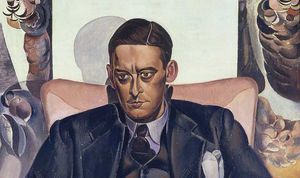July 19, 2004
Eliot and the Mythic Method
| “ | In manipulating a continuous parallel between contemporaneity and antiquity, Mr. Joyce is pursuing a method which others must pursue after him. They will not be imitators, any more than the scientist who uses the discoveries of an Einstein in pursuing his own, independent, further investigations. It is simply a way of controlling, of ordering, of giving shape and significance to the immense panorama of futility and anarchy which is contemporary history. It is a method already adumbrated by Mr. Yeats, and of the need for which I believe that Mr. Yeats to have been first contemporary to be conscious. Psychology (such as it is, and whether our reaction to it be comic or serious), ethnology, and The Golden Bough have concurred to make possible what was impossible even a few years ago. Instead of narrative method, we may now use the mythic method. It is, I seriously believe, a step toward making the modern world possible for art. | ” |
| — T.S. Eliot, “Ulysses, Order, and Myth” (1923) | ||
Eliot defines what he exemplifies in The Waste Land—i.e. the “mythic method”—in his essay “Ulysses, Order, and Myth.” The mythic method looked to the past to glean meaning and understanding for what has been lost or destroyed in the present. This method emphasizes the underlying commonality of ostensibly disparate times and locations by employing a comparative mythology to transcend the temporal narrative. By stressing the mythical, anthropological, historical, and the literary, this method becomes at once
- satirical by showing how much the present has fallen;
- comparative to highlight similarities structurally;
- historically neutral to escape the present to a revived future;
- confused in its fusion of the realistic and the phantasmagoric; and
- ordering in its approach to morality and imaginative passion.
The mythic method does not offer an escape to a better past, but an entry to a confusing present.
This method highlighted the reader's participation, by diminishing the authoritative voice of the poet. The voices of the past mingle with fragments of modern life that the reader must then interpret and order. The reader must structure the discontinuity and make her own connections within the text in a sort of quest, rather than being lead by the narratorial voice. The Waste Land’s thematic quest is then linked with the reader's own understanding and coupling of the discontinuous fragments of Eliot's polysemous style. The Waste Land is indeed a language experiment, refreshing and renewing in its random flow of verbal associations that disrupt the controlled and precise poetry of the Victorians. It echoes musically and free, like the flow of the Thames to the sea, not constrained by stifling literary conventions and traditional expectations. This is what makes Eliot difficult, but rewarding.
The Waste Land disrupts many of our expectations, especially on a first reading, and resists our attempts at a unified reading. First, its genre seems confused, more of a poem of the not-yet than one that we can comfortably inhabit. Indeed, Eliot seems to capture the modernist zeitgeist: i.e., that of crisis and rupture—the sheer absence of one, totalizing view of the world. One voice will not provide answers for all. Eliot shows the impossibility of one stable voice by mixing wit and humor even in the face of horror. The Waste Land is anti-heroic and unromantic, nightmarish and fantastic, realistic and dreadful, mundane and otherworldly. Even while we catch glimpses of the comfortable, Eliot never lingers long, confronting the reader with new multiplicity.
While the poem seeks stability, it does end that way. It does end with hope, but also with confusion and uncertainty, and a sense of alienation. We all have a choice, it seems, to set our own lands in order, to shore those fragments against our ruins. However, those fragments and voices will always echo, allowing only brief comfort, if any at all: shantih is peace beyond understanding, and the modern Wastelanders seem still to not understand. Perhaps this is the beginning of the myth of the twentieth century, one we still seem compelled to follow.
